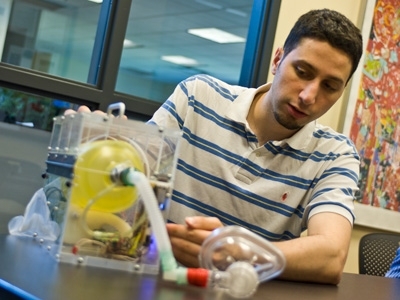In India a few years ago, a 30-year-old farmer was admitted to a hospital in the city of Lucknow, and over the next few days developed paralysis that prevented him from being able to breathe on his own. The kind of mechanical ventilator that would be used in most major medical facilities to keep him alive wasn’t available, but the hospital did have a bag-valve mask — a small, inexpensive plastic medical hand pump that could be used to force air carefully into the patient’s lungs. The farmer’s mother and brother took turns, squeezing the device 15 times a minute nonstop for 18 full days and nights, which kept him alive until a mechanical ventilator became available. Thirty days after being admitted to the hospital, the patient recovered enough to be weaned off the ventilator, and two weeks later he was sent home.
This is thought to be a record for the length of time a person has been kept alive by manually operated ventilation, and it underscores the need for simple, inexpensive, widely available equipment that could do the job without requiring such extraordinary and heroic efforts.
Now a team of students from MIT has devised a better way to keep patients breathing in places that lack standard mechanical ventilators, or during times of emergency such as pandemics or natural disasters, when normal hospital resources may be overextended. They have designed a system that uses the same widely available manual pump — the same type used for the farmer in India. The new system encases the pump in a plastic box with a battery, motor and controls to take the place of the manual compression process.
There is a substantial need for such devices in many developing nations, especially in rural areas that have no access to existing ventilator technology. Dr. Jussi Saukkonen of Boston University Medical Center, who originally proposed the concept of the low-cost ventilator and worked with the MIT team, says that “it’s likely there would be millions of cases worldwide” that could benefit from such a device. In addition, a U.S. government study in 2005 found that in a worst-case pandemic scenario, this country alone might need more than 700,000 mechanical ventilators, while only 100,000 are now in use.
The kind of ventilators used in modern hospitals can cost up to $30,000, but the newly developed device can be produced for about $100, says Abdul Mohsen Al Husseini, a graduate student in mechanical engineering and one of the students who developed the system. While there are some situations where it can’t perform all the same functions as the more expensive versions, for 98 percent of cases, this simple inexpensive device could do the job, he says.
“These manual devices are available everywhere,” Al Husseini says. “Our approach is to adapt them, since they’re already there.”
Simple system
The simple system has a curved plastic cam that compresses the device and then releases. It has just three control knobs; these adjust the total volume of air delivered in each breath, the number of breaths per minute, and the ratio of time between inhaling and exhaling.
Al Husseini explains that the mechanical system could not only eliminate the need for a person to operate the device manually in an emergency — it could also be safer. “There’s a danger, with manual ventilation, of overpressurizing” the patient’s lungs, which can cause serious damage, he says. The new system includes a gauge that stops the flow before the pressure gets too high.
The idea began as a class project in an MIT mechanical engineering course called Precision Machine Design, in which doctors from Boston-area hospitals present problems awaiting solutions, and the students choose which ones to address. A first prototype was developed in that class, and some of the students refined the design and produced a second prototype in a follow-up class, Development of Mechanical Products. They filed for a patent and presented a paper on the system to the Design of Medical Devices Conference in April of this year. Now some of the students are preparing to do further testing and develop the idea so it can be licensed for manufacturing.
One of the students, Amelia Servi, traveled to Nicaragua this summer to analyze the need for such a device and how to bring it to market as a real product, as part of her thesis research for her master’s degree.
Dr. Augustine Choi, chief of pulmonary and critical care medicine at Brigham and Women's Hospital, who was not involved in this project, says there is an “unmet medical need” for a low-cost ventilator, and if one becomes available “it will have impact throughout the world, especially in parts of the world where regular ventilators are not available.” He adds that a number of low-cost ventilators with different mechanisms have been proposed, so a key issue is to prove the reproducibility and quality assurance of this system.
The development of the device was supported in part by the Center for Integration of Medicine and Innovative Technology (which receives some funding from the U.S. Department of Defense). The work in Nicaragua is supported by MIT’s Public Service Center.
In The World is a column that explores the ways members of the MIT community are developing technology — from the appropriately simple to the cutting edge — to help meet the needs of communities around the planet, especially those in the developing world. If you have suggestions for future columns, please e-mail newsoffice@mit.edu.
Low-cost portable ventilator could be a lifesaver for people in remote locations and for hospitals in the developing world.
Publication Date:

Caption:
A working prototype of the mechanical ventilator developed by MIT students. They are working on a new version designed for easy manufacturability and maintenance.
Credits:
Photo: Patrick Gillooly

Caption:
Graduate student Abdul al Husseini demonstrates the features of the mechanical ventilator he and his fellow students designed.
Credits:
Photo: Patrick Gillooly





